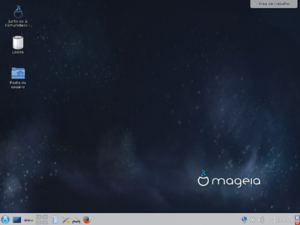Mageia
 |
|

Screenshot of Mageia 5 KDE
|
|
| OS family | Unix-like |
|---|---|
| Source model | Free and Open source |
| Initial release | June 1, 2011 |
| Latest release | 5.1 (December 2, 2016) |
| Latest preview | (none) |
| Available in | 167 languages |
| Update method | urpmi (rpmdrake) |
| Package manager | RPM |
| Platforms | IA-32, x86-64 |
| Kernel type | Monolithic (Linux) |
| Userland | GNU |
| Default user interface | KDE Plasma Desktop (DVD), GNOME 3 Desktop (DVD), LXDE (CD) |
| License |
Free software licenses (mainly GPL) and other licenses. |
| Official website | mageia |
Mageia is a Linux based operating system, distributed as free and open source software. It is forked from the Mandriva Linux distribution. Mageia was the first Linux distribution where MariaDB replaced Oracle's MySQL. The Greek term mageía (μαγεία) means enchantment, fascination, glamour, wizardry.
The first release of the software distribution, Mageia 1, took place in June 2011.
Mageia was created in 2010 as a fork of Mandriva Linux, by a group of former employees of Mandriva S.A. and several other developers and users and supporters of the Mandriva community.
On September 2, 2010, Edge IT, one of the subsidiaries of Mandriva, was placed under liquidation process by the Tribunal de commerce in Paris; effective by September 17, all assets were liquidated and employees were let go.
The next day, on September 18, 2010, some of these former employees, who were mostly responsible for the development and maintenance of the Mandriva Linux distribution, and several community members announced the creation of Mageia, with the support of many members of the community of developers, users and employees of Mandriva Linux.
Like many other distributions, Mageia uses all major desktop environments. Similar to Mandrake/Mandriva Linux, KDE is the main and the most used environment. End-users can choose from KDE and GNOME for the small installation DVD edition, any environment in full DVD edition and Xfce on the dual-arch CD. It uses Mageia Control Center.
Mageia is planned to be released on a 9-month release cycle, with each release to be supported for 18 months.
...
Wikipedia
